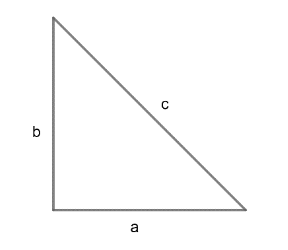
In a right – angled triangle, the sided are $a,b\text{ and }c,$ with $c$ as hypotenuse and
$c-b\ne 1,c+b\ne 1.$ Then the value of $\dfrac{\left( {{\log }_{c+b}}a+{{\log }_{c-b}}a \right)}{\left(
2{{\log }_{c+b}}a\times {{\log }_{c-b}}a \right)}$
A. $2$
B. $-1$
C. $\dfrac{1}{2}$
D. $1$
Answer
608.4k+ views
Hint: Use ${{\log }_{a}}b=\dfrac{1}{{{\log }_{b}}a}$ and basic formula of right angle
triangle.
As we have given that $a,b\text{ and }c$are sides of right – angled triangle with $c$ as
hypotenuse.

By Pythagoras theorem:
${{c}^{2}}={{b}^{2}}+{{a}^{2}}..........\left( i \right)$
The given expression of which we need to find value is:
$\begin{align}
& =\dfrac{{{\log }_{c+b}}a+{{\log }_{c-b}}a}{2{{\log }_{c+b}}a\times {{\log }_{c-b}}a} \\
& =\dfrac{{{\log }_{c+b}}a}{2{{\log }_{c+b}}a\times {{\log }_{c-b}}a}+\dfrac{{{\log
}_{c-b}}a}{2{{\log
}_{c+b}}a\times {{\log }_{c-b}}a} \\
& =\dfrac{1}{2{{\log }_{c-b}}a}+\dfrac{1}{2{{\log }_{c+b}}a} \\
& =\dfrac{1}{2}\left( {{\log }_{a}}\left( c-b \right)+{{\log }_{a}}\left( c+b \right)
\right)\text{
}\because \left( {{\log }_{a}}b=\dfrac{1}{{{\log }_{b}}a} \right) \\
& =\dfrac{1}{2}{{\log }_{a}}\left( c-b \right)\left( c+b \right)\text{ }\because \left(
{{\log }_{x}}a+{{\log }_{x}}b={{\log }_{x}}ab \right) \\
& =\dfrac{1}{2}{{\log }_{a}}{{c}^{2}}-{{b}^{2}}.................\left( ii \right) \\
\end{align}$
From the equation (i)
${{c}^{2}}={{b}^{2}}+{{a}^{2}}$
Hence, equation (ii) will become
$\begin{align}
& =\dfrac{1}{2}lo{{a}_{a}}{{a}^{2}} \\
& =\dfrac{2}{2}{{\log }_{a}}a\text{ }\left( {{\log }_{x}}{{a}^{n}}=n{{\log }_{x}}a \right) \\
& ={{\log }_{a}}a \\
& =1 \\
\end{align}$
Hence, option D is the correct answer.
Note: (i) One need to remember the basic formula between logarithmic functions as used in
the solution for the flexibility which is an important part of the solution with respect to the
calculation point of view.
(ii) One can change the given expression in following way:
$\begin{align}
& \dfrac{{{\log }_{c+b}}a+{{\log }_{c-b}}a}{2{{\log }_{c+b}}a.{{\log }_{c-b}}a} \\
& =\dfrac{\dfrac{{{\log }_{x}}a}{{{\log }_{x}}\left( c+b \right)}+\dfrac{{{\log }_{x}}a}{{{\log
}_{x}}\left(
c-b \right)}}{\dfrac{2{{\log }_{x}}a}{{{\log }_{x}}\left( c+b \right)}\times \dfrac{{{\log
}_{x}}a}{{{\log
}_{x}}\left( c-b \right)}} \\
\end{align}$
As we have formula ${{\log }_{a}}b=\dfrac{{{\log }_{c}}b}{{{\log }_{c}}a}$ with positive $c$.
And simplifying the above expression will also give the answer, but at the end the same
calculation is required. So no need to change the bases of given logarithm functions. We can
observe the expression and need to solve in the same way as done in the solution.
triangle.
As we have given that $a,b\text{ and }c$are sides of right – angled triangle with $c$ as
hypotenuse.

By Pythagoras theorem:
${{c}^{2}}={{b}^{2}}+{{a}^{2}}..........\left( i \right)$
The given expression of which we need to find value is:
$\begin{align}
& =\dfrac{{{\log }_{c+b}}a+{{\log }_{c-b}}a}{2{{\log }_{c+b}}a\times {{\log }_{c-b}}a} \\
& =\dfrac{{{\log }_{c+b}}a}{2{{\log }_{c+b}}a\times {{\log }_{c-b}}a}+\dfrac{{{\log
}_{c-b}}a}{2{{\log
}_{c+b}}a\times {{\log }_{c-b}}a} \\
& =\dfrac{1}{2{{\log }_{c-b}}a}+\dfrac{1}{2{{\log }_{c+b}}a} \\
& =\dfrac{1}{2}\left( {{\log }_{a}}\left( c-b \right)+{{\log }_{a}}\left( c+b \right)
\right)\text{
}\because \left( {{\log }_{a}}b=\dfrac{1}{{{\log }_{b}}a} \right) \\
& =\dfrac{1}{2}{{\log }_{a}}\left( c-b \right)\left( c+b \right)\text{ }\because \left(
{{\log }_{x}}a+{{\log }_{x}}b={{\log }_{x}}ab \right) \\
& =\dfrac{1}{2}{{\log }_{a}}{{c}^{2}}-{{b}^{2}}.................\left( ii \right) \\
\end{align}$
From the equation (i)
${{c}^{2}}={{b}^{2}}+{{a}^{2}}$
Hence, equation (ii) will become
$\begin{align}
& =\dfrac{1}{2}lo{{a}_{a}}{{a}^{2}} \\
& =\dfrac{2}{2}{{\log }_{a}}a\text{ }\left( {{\log }_{x}}{{a}^{n}}=n{{\log }_{x}}a \right) \\
& ={{\log }_{a}}a \\
& =1 \\
\end{align}$
Hence, option D is the correct answer.
Note: (i) One need to remember the basic formula between logarithmic functions as used in
the solution for the flexibility which is an important part of the solution with respect to the
calculation point of view.
(ii) One can change the given expression in following way:
$\begin{align}
& \dfrac{{{\log }_{c+b}}a+{{\log }_{c-b}}a}{2{{\log }_{c+b}}a.{{\log }_{c-b}}a} \\
& =\dfrac{\dfrac{{{\log }_{x}}a}{{{\log }_{x}}\left( c+b \right)}+\dfrac{{{\log }_{x}}a}{{{\log
}_{x}}\left(
c-b \right)}}{\dfrac{2{{\log }_{x}}a}{{{\log }_{x}}\left( c+b \right)}\times \dfrac{{{\log
}_{x}}a}{{{\log
}_{x}}\left( c-b \right)}} \\
\end{align}$
As we have formula ${{\log }_{a}}b=\dfrac{{{\log }_{c}}b}{{{\log }_{c}}a}$ with positive $c$.
And simplifying the above expression will also give the answer, but at the end the same
calculation is required. So no need to change the bases of given logarithm functions. We can
observe the expression and need to solve in the same way as done in the solution.
Recently Updated Pages
Master Class 9 Social Science: Engaging Questions & Answers for Success

Master Class 9 Science: Engaging Questions & Answers for Success

Master Class 9 English: Engaging Questions & Answers for Success

Master Class 9 Maths: Engaging Questions & Answers for Success

Master Class 9 General Knowledge: Engaging Questions & Answers for Success

Class 9 Question and Answer - Your Ultimate Solutions Guide

Trending doubts
Which places in India experience sunrise first and class 9 social science CBSE

Fill the blanks with the suitable prepositions 1 The class 9 english CBSE

Write the 6 fundamental rights of India and explain in detail

Difference Between Plant Cell and Animal Cell

What is pollution? How many types of pollution? Define it

What is the Full Form of ISI and RAW





